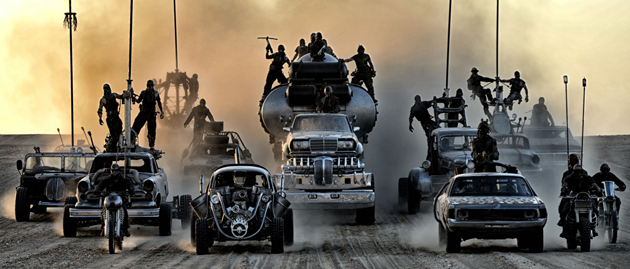Colin Gibson

AS: What exactly did George show you in those first meetings?
George, Brendan McCarthy, Peter Pound and Mark Sexton had initially built the story in storyboards rather than with words. There was nothing written, nothing in the way of dialog. There was also some enthralling concept art that Brendan had done, fantasy in the true sense of the word. The concept art was glorious but very, very fantasy and not especially up my street. I’m a little too much in love with physics. I like to define gravity and then defy it but I don’t like to pretend it doesn’t exist and CG my way around it. The reason I was brought in was in part to bring some rigour, physics and truth back to the action. Instead of my being an anchor on George’s imagination I think the tension, like the tension in real world gravity, worked to our advantage.
But storyboards are terrifying things where in one storyboard there are two people filling the cabin of a car and in the next storyboard there are eleven and there still seems to be enough room for a football team.
AS: How did you first meet George Miller?
CG: George ran Kennedy Miller, which became Kennedy Miller Mitchell, which is a production company. I had done a couple of jobs for him in his capacity as producer. He was producing films and telemovies and the odd mini-series for television. I was meant to be on Thunderdome but had to absent myself at the very start of production shooting because my son was about to be born. They didn’t talk to me for a while but then fortunately I was brought back in and I worked on Babe and then Babe 2 and then just as George started work on Happy Feet he offered me Fury Road.
AS: On Fury Road, how many of the final set pieces and vehicles closely resembled the original storyboards?
CG: In the action and pacing, they were remarkably true to conception. Storyboards by their nature are not very detailed, however. One car looks pretty much like the next ten or twelve that are drawn in the storyboards.
Brendan McCarthy is a great graphic novelist and his concept art was beautiful but much didn’t really fit within the rules that we started to impose. Everything had to follow the logic of the Wasteland where there were minimal amounts of fuel and water, a finite universe of salvage. If something didn’t have a believable form and function or it didn’t appear to be valuable enough to have survived, it was jettisoned and we had to find another way in.
Unfortunately hovercrafts the size of football fields or 747’s welded to Amtrak trains being hauled across the desert by a dozen prancing semi-trailers didn’t really fit with the notion that there’s probably only two gallons of fuel left and is that the last pair of pantyhose in civilization?